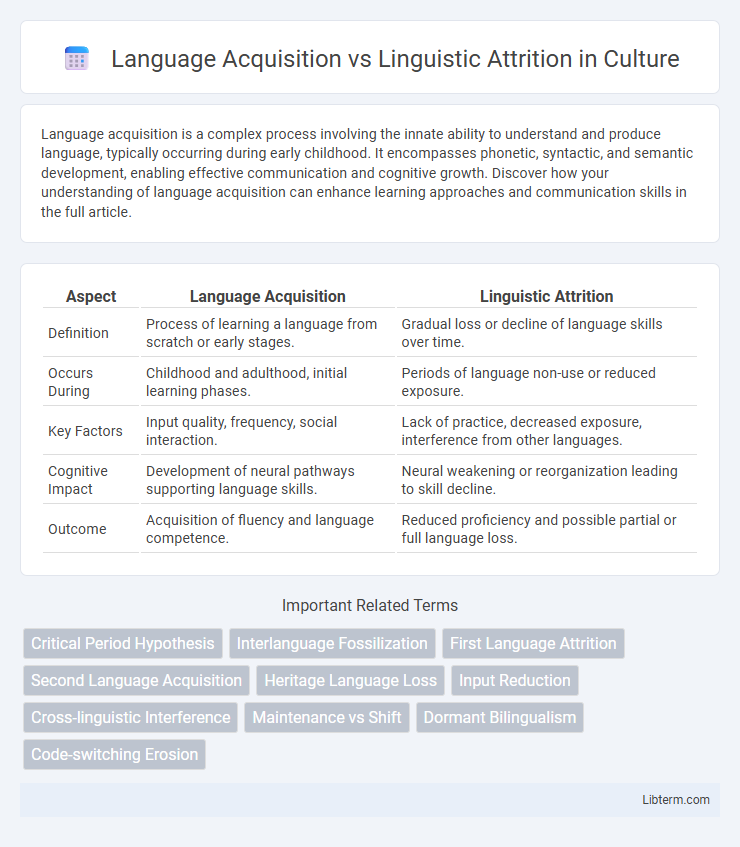Language acquisition is a complex process involving the innate ability to understand and produce language, typically occurring during early childhood. It encompasses phonetic, syntactic, and semantic development, enabling effective communication and cognitive growth. Discover how your understanding of language acquisition can enhance learning approaches and communication skills in the full article.
Table of Comparison
| Aspect | Language Acquisition | Linguistic Attrition |
|---|---|---|
| Definition | Process of learning a language from scratch or early stages. | Gradual loss or decline of language skills over time. |
| Occurs During | Childhood and adulthood, initial learning phases. | Periods of language non-use or reduced exposure. |
| Key Factors | Input quality, frequency, social interaction. | Lack of practice, decreased exposure, interference from other languages. |
| Cognitive Impact | Development of neural pathways supporting language skills. | Neural weakening or reorganization leading to skill decline. |
| Outcome | Acquisition of fluency and language competence. | Reduced proficiency and possible partial or full language loss. |
Introduction to Language Acquisition and Linguistic Attrition
Language acquisition refers to the natural, unconscious process by which individuals develop the ability to understand and produce language, typically occurring in early childhood and involving the internalization of phonology, syntax, and semantics. Linguistic attrition involves the gradual loss or decline of language proficiency, often affecting a language that was once dominant or fully acquired, due to factors like reduced use or environmental changes. Both processes highlight the dynamic nature of language competence, with acquisition emphasizing initial development and attrition focusing on the erosion of linguistic skills.
Defining Language Acquisition: Foundations and Phases
Language acquisition encompasses the natural process of acquiring the ability to perceive, comprehend, and produce language, primarily during early childhood through exposure and interaction. Foundational phases include the pre-linguistic stage with babbling and sound recognition, followed by the holophrastic stage where single words are used, and the telegraphic stage characterized by simple two-word combinations. These stages establish the cognitive and neural mechanisms essential for fluency, contrasting with linguistic attrition, which involves the loss or decline of language skills over time.
Understanding Linguistic Attrition: Causes and Manifestations
Linguistic attrition occurs when previously acquired language skills deteriorate due to lack of use, interference from other languages, or cognitive changes. Common causes include prolonged language disuse, environmental shifts, and decreased exposure to native speakers, leading to vocabulary loss, reduced fluency, and syntactic simplifications. Manifestations often present as difficulty in word retrieval, grammatical errors, and diminished pronunciation accuracy, reflecting the gradual erosion of language competence.
Key Differences Between Acquisition and Attrition
Language acquisition involves the initial process of learning a language, typically during childhood, leading to the development of native-like proficiency and deep grammatical understanding. Linguistic attrition refers to the gradual loss or decline of language skills, often due to lack of use or exposure, which can result in weakened vocabulary, fluency, and linguistic structures. Key differences include acquisition as an active, constructive process of gaining language competence, while attrition is a passive, often involuntary process marked by language decay and diminished communicative ability.
Neurological Perspectives on Language Learning and Loss
Neurological studies reveal that language acquisition involves the activation and strengthening of neural pathways in the brain's left hemisphere, particularly in areas like Broca's and Wernicke's regions, which are responsible for language production and comprehension. In contrast, linguistic attrition shows a reduction in neural connectivity and decreased activity in these language centers, often due to disuse or cognitive aging. Neuroplasticity plays a critical role in both processes, as it enables the brain to adapt by forming new connections during language learning and also leads to synaptic pruning when linguistic skills decline.
Factors Influencing Language Acquisition
Factors influencing language acquisition include age, exposure frequency, motivation, and cognitive abilities. Younger learners typically acquire languages more naturally due to brain plasticity, while consistent exposure enhances vocabulary and grammar retention. Social interaction and cultural immersion also significantly boost language acquisition speed and proficiency.
Drivers and Catalysts of Linguistic Attrition
Linguistic attrition primarily occurs due to reduced exposure and use of a previously acquired language, often driven by environmental changes such as migration or shifts in social context. Cognitive factors like memory decay and interference from dominant languages act as catalysts, accelerating the loss of linguistic proficiency over time. Emotional and motivational aspects, including decreased identity association with the language, also significantly influence the degree and speed of attrition.
The Role of Age in Acquisition and Attrition
Age plays a crucial role in language acquisition, with younger learners typically achieving higher proficiency and native-like accents due to greater neural plasticity during critical periods. In contrast, linguistic attrition often occurs more rapidly or deeply in languages learned later in life, as older brains show reduced capacity for maintaining less-used languages. Studies highlight that early childhood acquisition strengthens long-term retention, whereas languages acquired at an older age are more susceptible to attrition without continuous practice.
Strategies to Enhance Acquisition and Prevent Attrition
Effective strategies to enhance language acquisition include immersive exposure, consistent practice, and interactive communication to reinforce vocabulary and grammar skills. Preventing linguistic attrition involves regular language use, engaging in culturally relevant content, and maintaining social connections with native speakers. Utilizing technology like language apps and participating in language exchange programs significantly supports both acquisition and retention.
Implications for Language Education and Policy
Language acquisition involves the process of learning and internalizing a new language, primarily during early childhood or through immersive exposure, while linguistic attrition refers to the gradual loss of language proficiency due to lack of use or exposure. Understanding the dynamics between these two phenomena is critical for shaping language education policies that promote sustained bilingualism, effective maintenance programs, and targeted interventions for at-risk populations. Educational strategies should emphasize consistent language input and community engagement to prevent attrition and enhance long-term language retention among learners.
Language Acquisition Infographic

 libterm.com
libterm.com